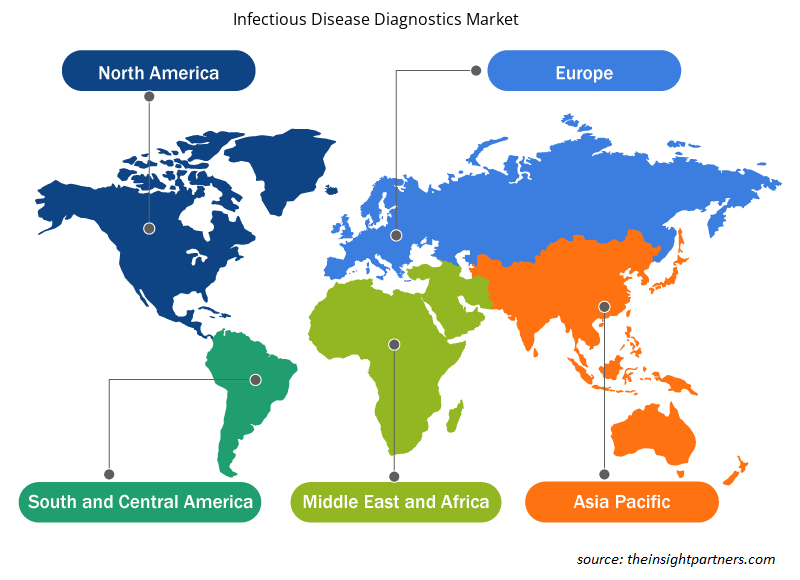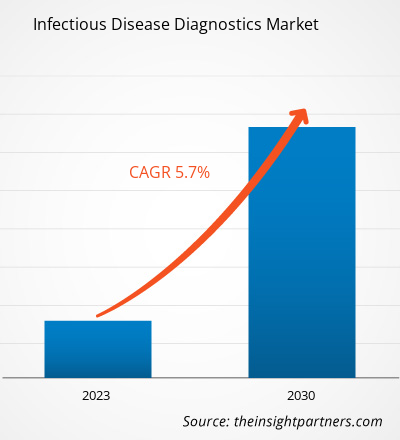[研究报告] 传染病诊断市场预计将从 2022 年的 383.6638 亿美元增长到 2030 年的 599.5422 亿美元;预计 2022 年至 2030 年的复合年增长率为 5.7%。
市场洞察和分析师观点:
随着传染病病例的增加以及由于技术先进产品的开发而导致的产品发布和产品批准的增加,传染病诊断市场规模正在扩大。2022 年 5 月,BD 在美国推出了其全自动高通量传染病分子诊断平台——BD COR MX 仪器。该仪器自动化并集成了完整的分子实验室工作流程,从样本处理到大型高通量实验室的诊断测试结果。BD COR 系统消除了对样本进行分类的任务,帮助实验室技术人员与样本的互动最少,从而为其他关键的实验室流程腾出时间。为了应对传染病病例的增加以及实验室能力和分子检测试剂的短缺,一些诊断检测制造商提供了快速且易于使用的设备,以促进实验室外的检测。
增长动力和挑战:
兽医传染病对家畜、牲畜和野生动物的健康产生负面影响。由于密集的畜牧业,每年在室内饲养的数十亿只动物往往健康状况不佳,由于基因和物理上的接近,为疾病流行的出现和蔓延提供了条件。此外,由于农业用地扩大导致森林砍伐,畜牧业助长了野生动物感染的传播。
能够及早发现新发传染病的诊断技术对于减少此类疾病爆发造成的经济损失至关重要。聚合酶链反应 ( PCR ) 仍然是全球最广泛使用的检测动物病原体的分子检测方法。这种诊断方法易于使用、经济高效、敏感且特异性强,能够进行大量检测。
定制此报告以满足您的需求
您可以免费定制任何报告,包括本报告的部分内容、国家级分析、Excel 数据包,以及为初创企业和大学提供优惠和折扣
- 获取此报告的关键市场趋势。这个免费样品将包括数据分析,从市场趋势到估计和预测。
尽管传统的病毒学方法非常可靠,但它们却非常耗时且费力。横向流动和酶联免疫吸附试验可用于快速检测。多重珠免疫或 Luminex 测定是一种基于荧光珠的高通量定量技术,用于在单一反应中同时检测针对不同传染病的多种特异性抗体,与传统的 ELISA 相比,可获得更快速、更经济、更准确的结果。此外,基于表面等离子体共振 (SPR) 的蛋白质芯片似乎是感染血清诊断或抗体滴定的快速有效工具。还可以使用 rDNA 技术在异源系统中生产重组抗体,并用于开发诊断测试。
即时诊断 (POCD) 是一种简单、快速且便携的诊断设备,可在现场检测疾病状态。近年来,实时 PCR (qPCR) 已转变为 POCD 平台。这些全自动平台结合了核酸提取、热循环和现场报告结果。例如,Enigma Diagnostics 的 MiniLab 是一个 10-35 公斤的分子诊断平台,可在现场携带,用于验证非洲猪瘟病毒、古典猪瘟病毒、禽流感病毒和口蹄疫病毒以供研究之用。英国 Primerdesign Ltd 的 genesig 检测试剂盒提供冻干 qPCR 检测试剂盒,用于诊断 62 种牛病、42 种马病、47 种猪病、60 种禽病、40 种犬病和 26 种猫病原体以供研究之用。同样,Boster 提供 Bosterbio qPCR 试剂盒,可检测多达 48 个单独或混合样本。它用于基因表达谱分析、目标 DNA 定量、微生物检测、病毒或细菌病原体负荷测定以及基于探针的 qPCR 引物对性能评估。
因此,PCR 和 qPCR 等用于诊断动物细菌、病毒、真菌和寄生虫感染的诊断方法正在推动兽医诊断的发展。
大多数诊断检测的低报销率阻碍了生产公司开发新检测并进行大规模研究以支持广泛使用。此外,如果没有预期结果的数据来支持新检测的成本效益或证明现有检测,报销率仍然很低。
新的或昂贵的诊断测试的报销困难和担忧可能会阻碍创新,并对诊断技术的广泛部署构成重大挑战。在美国,报销包括第三方付款人的承保、对医疗服务或条件进行编码以确定付款,以及确定付款水平。
对于带有现行程序术语 (CPT) 代码的门诊测试,医疗保险覆盖咨询委员会提倡医疗保险和医疗补助服务中心 (CMS) 提供诊断测试覆盖范围,包括确定足够的证据和健康福利。然而,大多数医疗保险报销决定都是在当地而不是在国家层面做出的。诊断测试的覆盖范围因地区而异。此外,缺乏确定覆盖范围的标准可能会对新诊断产品的开发和可用性构成挑战。
在某些情况下,报销不包括检测费用,这限制了实验室提供检测的能力,并降低了检测的可用性和使用率。在其他情况下,收费可能很高,但可能会给患者留下相当大的成本,这限制了医生定期订购检测。合规性和计费仍然是临床实验室面临的挑战,并限制了检测的可用性。因此,报销不足的情况阻碍了传染病诊断市场的增长。
报告细分和范围:
按产品划分,传染病诊断市场可细分为试剂盒和试剂、仪器以及软件和服务。按技术划分,传染病诊断市场可细分为基于生物传感器的诊断、免疫诊断、基于分子的诊断、临床生物学和其他诊断。免疫诊断细分市场进一步细分为酶联免疫吸附测定、蛋白质印迹分析和免疫荧光测定。基于分子的诊断技术细分市场进一步细分为聚合酶链反应、原位杂交、等温核酸扩增技术、下一代测序、DNA 微阵列和其他诊断。按应用类型划分,传染病诊断市场可分为即时诊断和实验室检测。按检测类型划分,传染病诊断市场可分为人体检测和兽医检测。人体检测细分市场进一步细分为 HIV、肝炎、HAI、HPV、结核病、流感和其他诊断。根据最终用户,传染病诊断市场分为诊断实验室、医院和诊所、研究机构、家庭护理机构和其他。根据地域,传染病诊断市场分为北美(美国、加拿大和墨西哥)、欧洲(英国、德国、法国、意大利、西班牙和欧洲其他地区)、亚太地区(中国、日本、印度、韩国、澳大利亚和亚太其他地区)、中东和非洲(阿联酋、沙特阿拉伯、南非和中东和非洲其他地区)以及南美洲和中美洲(巴西、阿根廷和南美洲和中美洲其他地区)。
节段分析:
传染病诊断市场按产品细分为试剂盒和试剂、仪器以及软件和服务。2022 年,试剂盒和试剂部分占据了最大的市场份额。然而,软件和服务部分的市场预计将在 2022-2030 年期间以最快的速度增长。由于 Abbott、F. Hoffmann-La Roche Ltd 和 Bio-Rad Laboratories, Inc. 等大量制造商的存在,试剂盒和试剂部分正在增长。此外,为了应对 HAI、流感和 HIV 等传染病病例的增加以及实验室分子检测能力和试剂的短缺,多家诊断测试制造商已经开发并开始销售快速且易于使用的设备,以方便在实验室环境之外进行测试。此外,试剂盒和试剂经常用于各种研究过程,产品发布量也在不断增加。例如,2021 年 7 月,Cepheid 宣布其 Xpert HIV-1 Viral Load XC 和 Xpert HIV-1 Qual XC 已获得 CE-IVD 批准,这是用于 HIV 检测的下一代扩展覆盖 (XC) 检测。Xpert HIV-1 Viral Load XC 为 HIV-1 检测提供了第二个目标,可提供扩展的菌株覆盖范围以提高性能并降低因基因突变或缺失导致假阴性结果的风险。因此,由于存在提供多种试剂和试剂盒的各种市场参与者以及技术进步的兴起,该细分市场预计将在预测期内增长。
由于技术进步和采用新软件来减轻传染病负担等因素,预计软件和服务部门将在未来几年内增长。许多公司正在推出软件来分析传染病发病率的上升,预测随时间变化的趋势和爆发情况,并评估遏制措施的有效性。因此,已经建立了几个统计模型,主要基于易感-暴露-感染-恢复或移除 (SEIR) 模型。此外,受科学界多学科和协作努力的启发,疾病建模研究所一直在构建建模工具,这些工具是研究和软件团队成员之间广泛合作的结果。这些工具提供了定量和分析手段,以模型表示传染病的传播。IDM 软件工具免费和公开地与科学界共享,以借助计算建模加快疾病根除工作。因此,主要参与者采取的此类举措也有望在未来几年推动该部门的增长。
区域分析:
根据地域划分,传染病诊断市场分为北美、欧洲、亚太地区、中东和非洲以及南美和中美洲。北美是全球传染病诊断市场增长的最大贡献者。预计亚太地区在 2022-2030 年期间的传染病诊断市场复合年增长率最高。美国传染病诊断市场的增长主要受传染病患病率上升、老年人口增加以及主要参与者推出的产品数量增加的推动。老龄化是传染病的一个突出风险因素,因为 60 岁以上的人通常免疫力低下。根据人口参考局 2020 年发布的一项研究,2020 年美国 65 岁及以上人口为 5500 万,预计到 2060 年这一数字将达到 9500 万。美国监管机构正在实施优惠政策,以开发用于诊断和治疗各种适应症的即时诊断 (POC) 产品。 2021 年 3 月,美国食品药品管理局 (FDA) 批准 Binx Health IO CT/NG 检测试剂可用于社区诊所、紧急护理环境和门诊医疗机构;这是首个用于诊断衣原体和淋病感染的 POC 检测产品。2022 年 5 月,全球领先的医疗技术公司之一碧迪公司 (BD) 宣布在美国市场推出其全新的、全自动、高通量传染病分子诊断平台。新的 BD COR MX 仪器作为 BD COR 平台的分析仪器选项推出,已获得 FDA 的 510(k) 批准。BD CTGCTV2 分子检测试剂是新系统上可用的首个检测试剂,它是一种单一检测试剂,可检测三种最常见的非病毒性性传播感染 (STI)——淋病奈瑟菌 (GC)、沙眼衣原体 (CT) 和阴道毛滴虫 (TV)。
传染病诊断市场区域洞察
Insight Partners 的分析师已详尽解释了预测期内影响传染病诊断市场的区域趋势和因素。本节还讨论了北美、欧洲、亚太地区、中东和非洲以及南美和中美洲的传染病诊断市场细分和地理位置。

- 获取传染病诊断市场的区域特定数据
传染病诊断市场报告范围
| 报告属性 | 细节 |
|---|---|
| 2022 年市场规模 | 383.7亿美元 |
| 2030 年市场规模 | 599.5亿美元 |
| 全球复合年增长率(2022 - 2030 年) | 5.7% |
| 史料 | 2020-2021 |
| 预测期 | 2023-2030 |
| 涵盖的领域 | 按产品
|
| 覆盖地区和国家 | 北美
|
| 市场领导者和主要公司简介 |
|
传染病诊断市场参与者密度:了解其对业务动态的影响
传染病诊断市场正在快速增长,这得益于终端用户需求的不断增长,而这些需求又源于消费者偏好的不断变化、技术进步以及对产品优势的认识不断提高等因素。随着需求的增加,企业正在扩大其产品范围,进行创新以满足消费者的需求,并利用新兴趋势,从而进一步推动市场增长。
市场参与者密度是指在特定市场或行业内运营的企业或公司的分布情况。它表明相对于给定市场空间的规模或总市场价值,有多少竞争对手(市场参与者)存在于该市场空间中。
在传染病诊断市场运营的主要公司有:
- 雅培实验室
- 布鲁克公司
- 康德乐
- F. 霍夫曼-罗氏有限公司
- 三一生物科技公司
免责声明:上面列出的公司没有按照任何特定顺序排列。

- 了解传染病诊断市场主要参与者概况
行业发展和未来机遇:
以下列出了传染病诊断市场主要参与者的各种举措:
- 2023 年 1 月,Trinity Biotech 宣布与 imaware Inc 建立战略合作伙伴关系,将他们为合作伙伴打造的数字健康平台与 Trinity Biotech 先进的参考实验室设施相结合,通过家庭和远程测试计划为数字健康行业提供支持。
- 2022 年 11 月,Bio-Rad Laboratories Inc 扩大了其独立质量控制产品组合,包括 InteliQ 和 Liquichek 紧凑型小瓶。这些产品将用于雅培的 Alinity CI 系列,该系列与临床化学和免疫分析测试仪器集成在一起。
- 2021 年 12 月,罗氏公司在接受 CE 标志的国家/地区推出了首批基于新型分子实验室仪器 cobas 5800 系统的传染病检测。这些检测包括 cobas HIV-1、cobas HBV、cobas HCV、cobas HIV-1/HIV-2 定性检测和 cobas omni Utility Channel 试剂盒。这些产品的推出扩展了罗氏分子产品组合,为低、中、高容量分子实验室检测需求提供了标准化的性能和效率。
竞争格局和重点公司:
雅培实验室、布鲁克公司、Cardinal Health、F. Hoffmann-La Roche Ltd、Trinity Biotech Plc、丹纳赫公司、Bio-Rad Laboratories Inc、AccuBioTech Co Ltd、ACON Laboratories 和 DiaSorin SpA 是传染病诊断市场上的知名企业。这些公司专注于新产品的推出和地域扩张,以满足全球日益增长的消费者需求,并扩大其专业产品组合的范围。他们的全球影响力使他们能够服务于庞大的客户群,从而促进市场扩张。
- 历史分析(2 年)、基准年、预测(7 年)及复合年增长率
- PEST 和 SWOT 分析
- 市场规模价值/数量 - 全球、区域、国家
- 行业和竞争格局
- Excel 数据集



Report Coverage
Revenue forecast, Company Analysis, Industry landscape, Growth factors, and Trends

Segment Covered
This text is related
to segments covered.

Regional Scope
North America, Europe, Asia Pacific, Middle East & Africa, South & Central America

Country Scope
This text is related
to country scope.
常见问题
The factors that are driving and restraining factors that will affect the infectious disease diagnostics market in the coming years Growth of the global infectious disease diagnostic market is majorly driven by increase in prevalence of infectious disease such as hepatitis, influenza, COVID-19, & human immuno deficiency virus (HIV); rise in demand for point-of-care diagnostic test; increase in funding from private & government organizations for diagnostic service centers; and advancements in technologies in the field of infectious disease diagnostics. However, lack of reimbursement policy is likely to hinder the market growth.
Infectious diseases are generated by microorganisms such as fungi, viruses, bacteria, and other organism species. Infectious disease diagnostics are the methods utilized by hospitals, clinical laboratories, and others to detect or identify foreign antigens/organisms by using several diagnostic tests. These tests assist in the identification of the kind of pathogen. Also, the level of the degree to which the disease is spread in the body. The diagnostic procedure may be sent with the aid of conventional diagnostic tests or point-of-care testing tools.
The infectious disease diagnostics market majorly consists of the players such as F.Hoffmann-La Roche, Ltd.; Danaher Corporation; BD; bioMérieux SA; AccuBioTech Co., Ltd.; Bio-Rad Laboratories, Inc.; ACON Laboratories, Inc.; Abbott; Trinity Biotech; and Cardinal Health, Inc. amongst others.
The infectious disease diagnostics market, by disease indication, is bifurcated into human testing and veterinary testing. In 2022, the human segment held a larger share of the market, by testing type. However, the veterinary segment is expected to witness a higher growth during the forecast period.
Trends and growth analysis reports related to Life Sciences : READ MORE..
The List of Companies - Infectious Disease Diagnostics Market
- Abbott Laboratories
- Bruker Corp
- Cardinal Health
- F. Hoffmann-La Roche Ltd
- Trinity Biotech Plc
- Danaher Corp
- Bio-Rad Laboratories Inc
- AccuBioTech Co Ltd
- ACON Laboratories
- DiaSorin SpA
The Insight Partners performs research in 4 major stages: Data Collection & Secondary Research, Primary Research, Data Analysis and Data Triangulation & Final Review.
- Data Collection and Secondary Research:
As a market research and consulting firm operating from a decade, we have published and advised several client across the globe. First step for any study will start with an assessment of currently available data and insights from existing reports. Further, historical and current market information is collected from Investor Presentations, Annual Reports, SEC Filings, etc., and other information related to company’s performance and market positioning are gathered from Paid Databases (Factiva, Hoovers, and Reuters) and various other publications available in public domain.
Several associations trade associates, technical forums, institutes, societies and organization are accessed to gain technical as well as market related insights through their publications such as research papers, blogs and press releases related to the studies are referred to get cues about the market. Further, white papers, journals, magazines, and other news articles published in last 3 years are scrutinized and analyzed to understand the current market trends.
- Primary Research:
The primarily interview analysis comprise of data obtained from industry participants interview and answers to survey questions gathered by in-house primary team.
For primary research, interviews are conducted with industry experts/CEOs/Marketing Managers/VPs/Subject Matter Experts from both demand and supply side to get a 360-degree view of the market. The primary team conducts several interviews based on the complexity of the markets to understand the various market trends and dynamics which makes research more credible and precise.
A typical research interview fulfils the following functions:
- Provides first-hand information on the market size, market trends, growth trends, competitive landscape, and outlook
- Validates and strengthens in-house secondary research findings
- Develops the analysis team’s expertise and market understanding
Primary research involves email interactions and telephone interviews for each market, category, segment, and sub-segment across geographies. The participants who typically take part in such a process include, but are not limited to:
- Industry participants: VPs, business development managers, market intelligence managers and national sales managers
- Outside experts: Valuation experts, research analysts and key opinion leaders specializing in the electronics and semiconductor industry.
Below is the breakup of our primary respondents by company, designation, and region:

Once we receive the confirmation from primary research sources or primary respondents, we finalize the base year market estimation and forecast the data as per the macroeconomic and microeconomic factors assessed during data collection.
- Data Analysis:
Once data is validated through both secondary as well as primary respondents, we finalize the market estimations by hypothesis formulation and factor analysis at regional and country level.
- Macro-Economic Factor Analysis:
We analyse macroeconomic indicators such the gross domestic product (GDP), increase in the demand for goods and services across industries, technological advancement, regional economic growth, governmental policies, the influence of COVID-19, PEST analysis, and other aspects. This analysis aids in setting benchmarks for various nations/regions and approximating market splits. Additionally, the general trend of the aforementioned components aid in determining the market's development possibilities.
- Country Level Data:
Various factors that are especially aligned to the country are taken into account to determine the market size for a certain area and country, including the presence of vendors, such as headquarters and offices, the country's GDP, demand patterns, and industry growth. To comprehend the market dynamics for the nation, a number of growth variables, inhibitors, application areas, and current market trends are researched. The aforementioned elements aid in determining the country's overall market's growth potential.
- Company Profile:
The “Table of Contents” is formulated by listing and analyzing more than 25 - 30 companies operating in the market ecosystem across geographies. However, we profile only 10 companies as a standard practice in our syndicate reports. These 10 companies comprise leading, emerging, and regional players. Nonetheless, our analysis is not restricted to the 10 listed companies, we also analyze other companies present in the market to develop a holistic view and understand the prevailing trends. The “Company Profiles” section in the report covers key facts, business description, products & services, financial information, SWOT analysis, and key developments. The financial information presented is extracted from the annual reports and official documents of the publicly listed companies. Upon collecting the information for the sections of respective companies, we verify them via various primary sources and then compile the data in respective company profiles. The company level information helps us in deriving the base number as well as in forecasting the market size.
- Developing Base Number:
Aggregation of sales statistics (2020-2022) and macro-economic factor, and other secondary and primary research insights are utilized to arrive at base number and related market shares for 2022. The data gaps are identified in this step and relevant market data is analyzed, collected from paid primary interviews or databases. On finalizing the base year market size, forecasts are developed on the basis of macro-economic, industry and market growth factors and company level analysis.
- Data Triangulation and Final Review:
The market findings and base year market size calculations are validated from supply as well as demand side. Demand side validations are based on macro-economic factor analysis and benchmarks for respective regions and countries. In case of supply side validations, revenues of major companies are estimated (in case not available) based on industry benchmark, approximate number of employees, product portfolio, and primary interviews revenues are gathered. Further revenue from target product/service segment is assessed to avoid overshooting of market statistics. In case of heavy deviations between supply and demand side values, all thes steps are repeated to achieve synchronization.
We follow an iterative model, wherein we share our research findings with Subject Matter Experts (SME’s) and Key Opinion Leaders (KOLs) until consensus view of the market is not formulated – this model negates any drastic deviation in the opinions of experts. Only validated and universally acceptable research findings are quoted in our reports.
We have important check points that we use to validate our research findings – which we call – data triangulation, where we validate the information, we generate from secondary sources with primary interviews and then we re-validate with our internal data bases and Subject matter experts. This comprehensive model enables us to deliver high quality, reliable data in shortest possible time.


 获取此报告的免费样本
获取此报告的免费样本